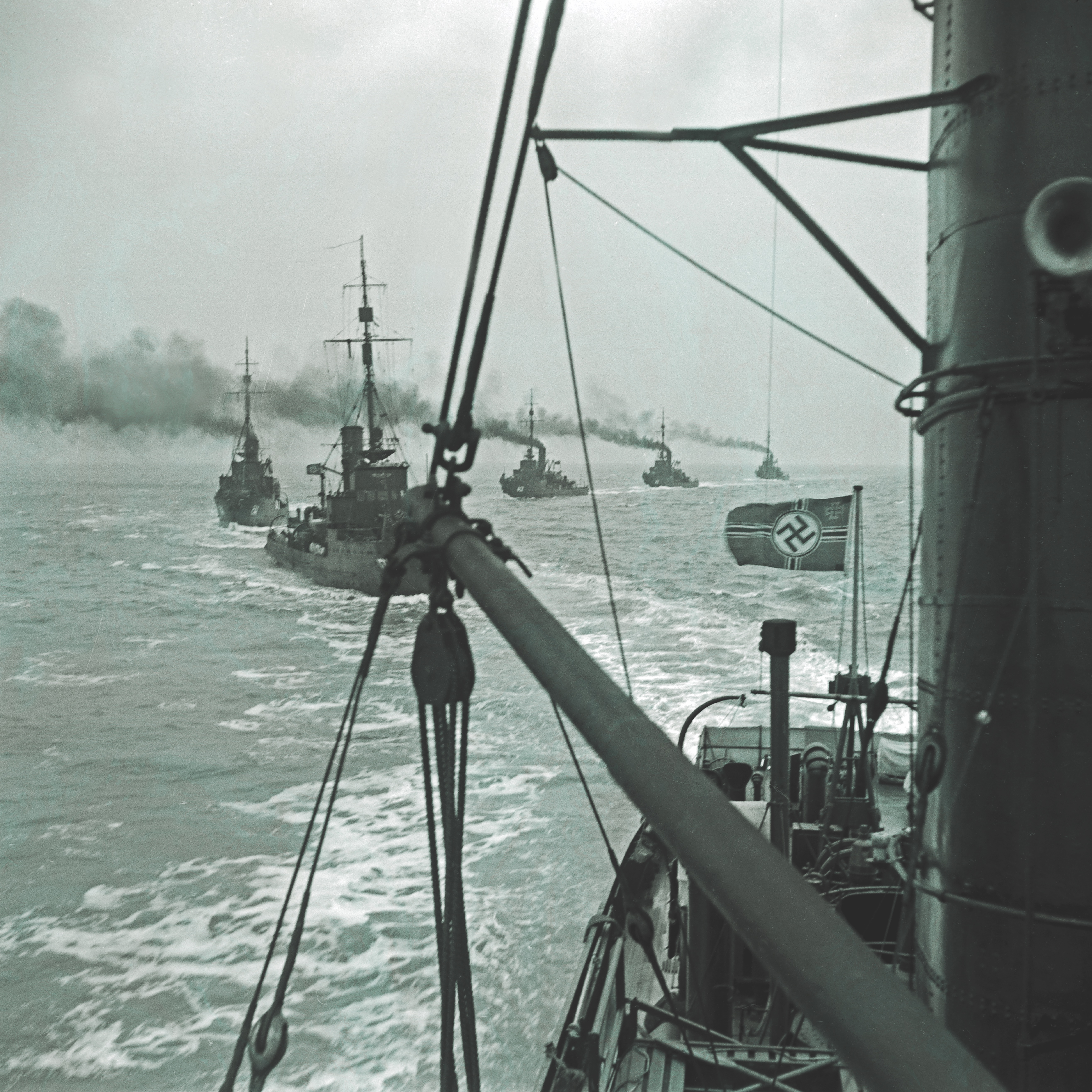In 1945 a German raiding force from the Channel Islands launched a daring attack on a port in Allied-occupied France
In the early winter of 1944–1945, the 30,000 German troops occupying the Channel Islands between Great Britain and France were miserably cold and hungry—as were the British subjects under their jackboots. Soldiers and civilians alike shivered on the windswept bits of land off the coast of Normandy and waited for the war to end.
By this point Germany’s occupation of the Channel Islands was well into its fifth year, but the successful Allied landings in France the previous summer had irreparably severed its supply lines. (The Allies had chosen to bypass the heavily fortified islands entirely, leaving them isolated in the rear.) All across Europe the winter had been unusually harsh, and although Britain was regularly shipping coal to France via the French port of Granville, none was going to the Channel Islands. The Germans allowed the International Red Cross relief ship SS Vega to drop off shipments of food, clothing, and medical supplies, but only occasionally.
“Let ’em starve,” British prime minister Winston Churchill had declared in September 1944. “No fighting. They can rot at their leisure.” It was unclear whether Churchill was referring the islanders or their German captors.
As the Wehrmacht commander on the Channel Islands, Lieutenant General Rudolf Graf von Schmettow, was desperately seeking a solution to the supply problem, one simply dropped in his lap. On December 21, 1944, four German paratroops and a navy midshipman who had been captured at Brest escaped from the Granville POW camp. They stole an American LCVP (Landing Craft, Vehicle, Personnel) from Granville Harbour and, with only a hand-drawn map and a pocket compass, had motored across 30 miles of treacherous Atlantic to Saint Helier on Jersey, the largest of the Channel Islands. The escapees told Schmettow that coal-laden colliers were arriving in the harbor every other day and that lightly guarded dockside warehouses were filled with cases of C-rations. Schmettow immediately began planning a raid on Granville to obtain much-needed food and coal for his troops.
The prisoners’ daredevil escape electrified hard-pressed Germans everywhere, and Adolf Hitler himself summoned the five men home to Berlin so that he could personally decorate them. But Allied night fighters downed their aircraft on Christmas night over Bastogne, Belgium, and all the men on board were killed.
As the first French port the Allies had liberated, Granville had briefly been the busiest, most important harbor in the world. Warehouses sprang up overnight, and 18 new cranes were erected to help bulk-load supplies onto railcars and transport trucks. As other ports came on line at Morlaix, Saint-Brieuc, and Saint-Malo, Granville became primarily a coal port, with convoys arriving every other day from the English port of Falmouth. A U.S. Army battalion guarded the installations at Granville, while U.S. Navy patrol boats prowled the islands nearby.
The first German raiding party sailed from Saint Helier on the night of February 7–8. It soon turned back, however, because of heavy swells and fog, mechanical problems, and its discovery by an alert U.S. Navy subchaser, PC-552, an hour after the flotilla set out. The captured LCVP from the POWs’ escape had joined the raid, but it foundered and had to be abandoned on the rocks south of Jersey. The lead raiders got close enough to the harbor to hear music coming from the beachfront Hôtel des Bains and Hôtel Normandie before heading back to Jersey empty-handed. The raiders had been able to recover and redeploy a number of British parachute mines at the northern approaches to Saint-Malo and had not been detected by Allied radar.
Vice Admiral Friedrich Hüffmeier took over command of the Channel Islands from Schmettow on February 20, and he ordered plans drawn up for another raid. The new blueprint included an amphibious assault with a main attack, a diversion, and remote security. The raiders’ ambitious goals were to destroy cargo-handling equipment, sink any cargo vessels in the harbor, bring away one or more coal-laden colliers, free German POWs, capture American officers, and destroy or render useless all enemy patrol craft in the area. The attack fleet would consist of 12 vessels in four groups, each group with a specific mission. Hüffmeier, a former captain of the battle cruiser Scharnhorst, enthusiastically endorsed the plan.
Hüffmeier’s promotion had nothing to do with his suitability or skills as a commander. Hitler, in the wake of a failed assassination attempt against him the previous summer, had begun replacing Wehrmacht army officers of questionable loyalty with rabid Nazi naval officers such as Hüffmeier, whose previous command had been an almost complete disaster. While serving on the captain’s bridge of Scharnhorst, Hüffmeier had run the ship aground on a sandbar, catapulted a reconnaissance aircraft off the deck (killing all but one crewman), wrapped a buoy cable around the starboard screw, and collided with another German vessel while on maneuvers in the Baltic Sea. He had even falsely claimed credit for leading Scharnhorst on a celebrated “Channel dash” weeks before he had even taken command of the vessel. The sailors under him were delighted to see him go, and the army officers now under his control considered him a fanatic, perhaps even a lunatic.
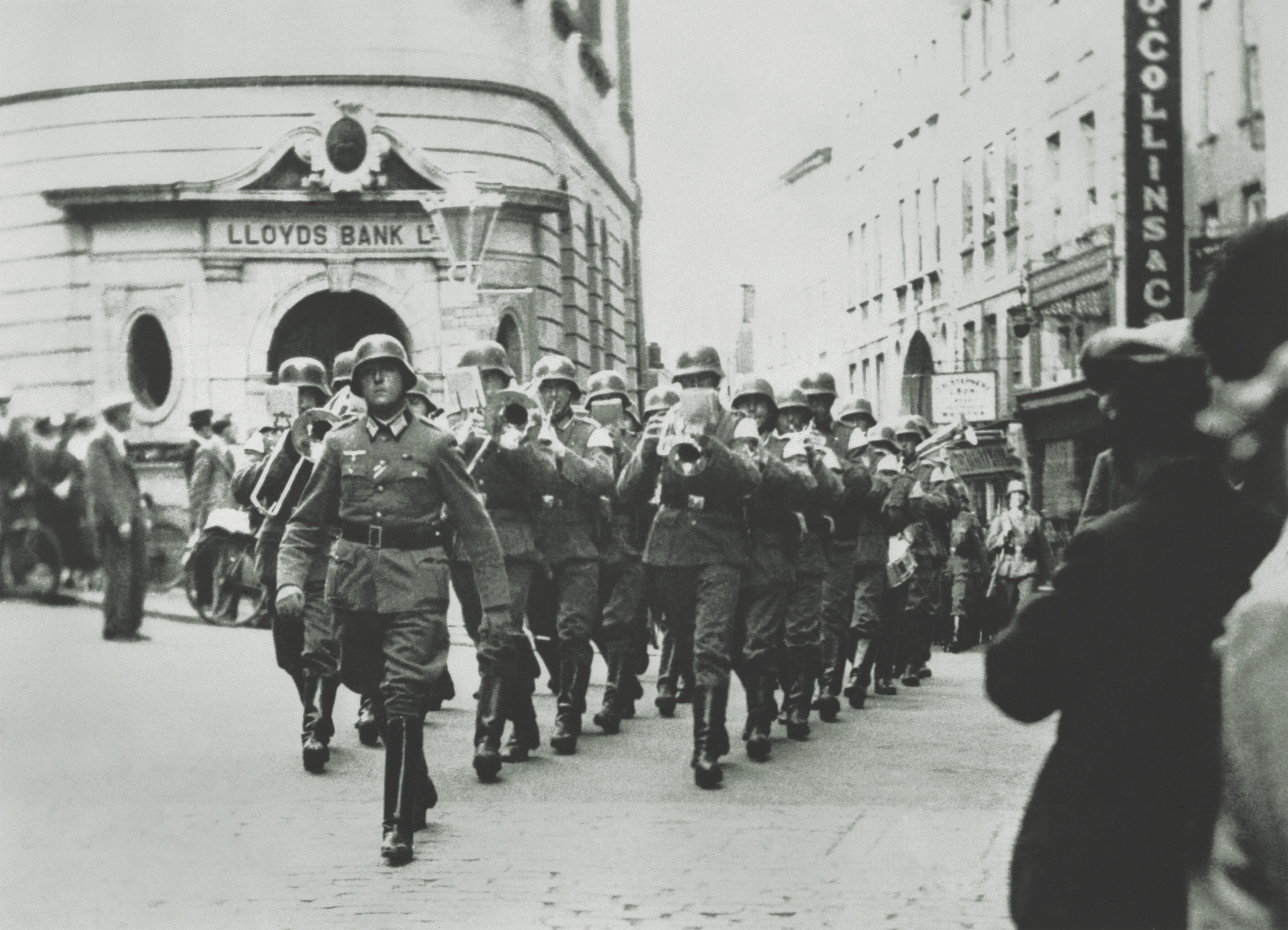
Preparations for a new raid on Granville continued apace, despite a suspicious fire and explosion at the Palace Hotel at Bagatelle, near Saint Helier, where the Germans were planning the raid. The incident, which claimed the lives of nine German soldiers and injured several others, occurred on March 7, the same day American infantrymen crossed the Ludendorff railway bridge at Remagen and entered Germany for the first time. It was not a good day for the German war effort.
Hüffmeier, undeterred, launched the second Granville raid one day later. He felt the need for speed. A collaborationist Frenchwoman working at the Hôtel des Bains had secretly informed the Germans that several high-ranking American officers were staying there. At the same time, Hüffmeier received reports of a new convoy of coal barges coming down from in England. The forecast for the often stormy Atlantic was fair, with calm seas and no moon. It was now or never.
Codenamed Kommando-Unternehmen Granville, the raid was led by 41-year-old Captain Lieutenant Carl-Friedrich Mohr. The invading flotilla consisted of six minesweepers, three fast motor launches, a large seagoing tugboat, three barges and assorted fighting boats and harbor craft. The raiding party—600 soldiers and sailors in all—was divided into five assault groups.
Each of the groups had a specific assignment: Group 1a was made up of the minesweepers M412 and M452 and numerous soldiers and naval personnel. Its mission was to demolish port facilities and the radar station and then provide crews for captured Allied ships. Mohr selected M412 as his command ship. Group 1b’s minesweepers, M432 and M442, would take up positions to shell the landward approaches to the harbor and prevent reinforcements from reaching Granville.
Group 2 included three armed ferry boats mounted with 88mm guns. Commanded by Lieutenant Otto Karl, its mission was to lure away the Granville guard ship and take on any other ships sent from Saint-Malo. To thwart possible pursuers, the group was also to destroy the lighthouse at Grand Chausey. Group 3, with three fast motor launches, would land diversionary forces and raid the Hôtel des Bains and Hôtel Normandie to seize any American officers housed there. Group 4, including the auxiliary minesweeper M4613 and the cutter FL13, would screen the Cotentin passage. Eight army assault groups were aboard the vessels in Groups 1a and 3; Group 1a also had a six-man Luftwaffe flak crew. Three naval assault groups were aboard Group 1b.
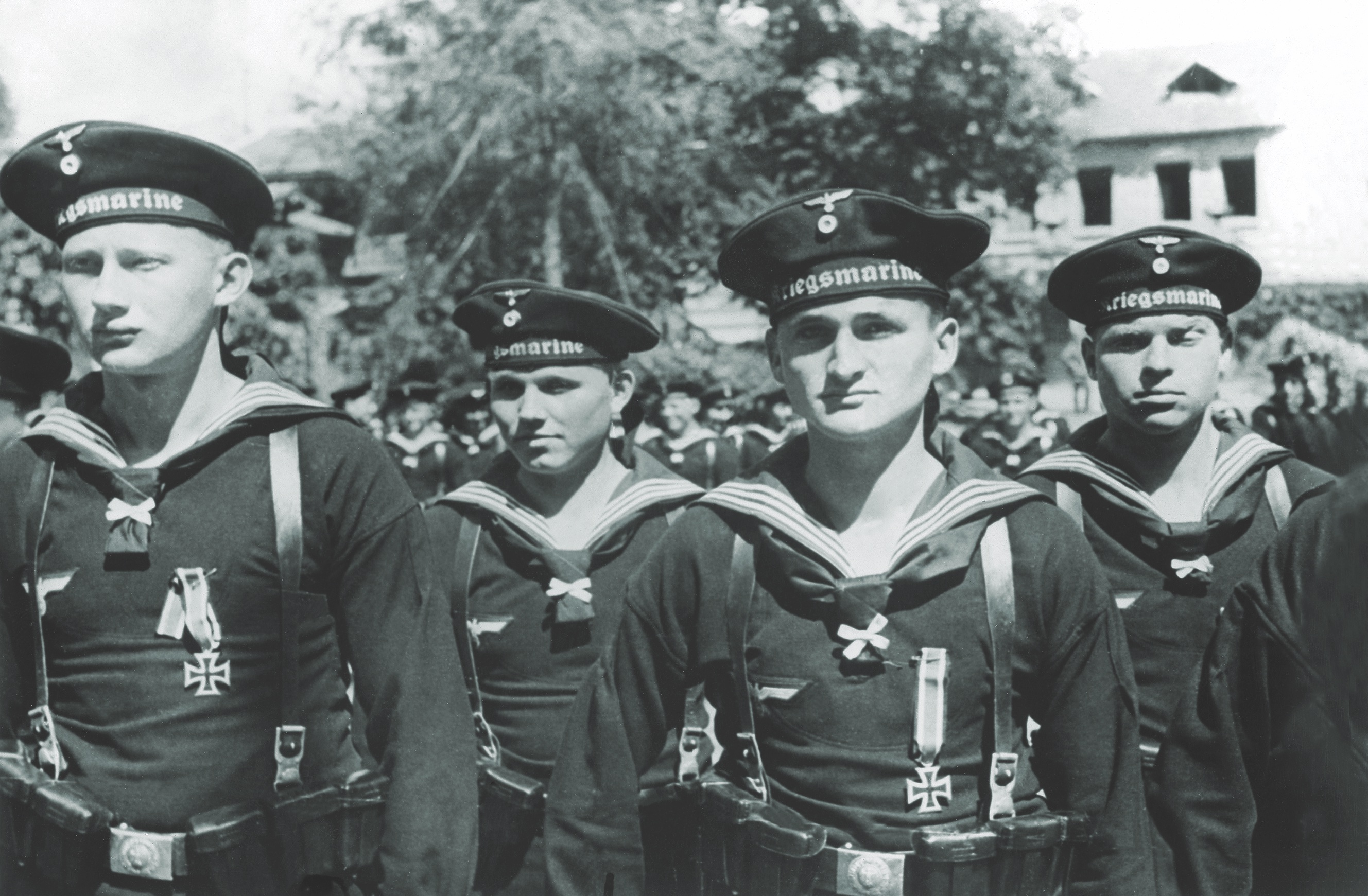
The Americans quickly detected the approaching German flotilla. Shortly before 10 p.m., the U.S. Army radar station at Coutainville reported an enemy vessel just 20 miles from Granville, moving at 10 knots. At the same time PC-564, commanded by Lieutenant Percy Sandel, was making its usual patrol off Granville. The British collier SS Gem was anchored three miles from the entrance to Granville Harbour. Gem had come out of Granville at high tide that afternoon and was to remain anchored until the five colliers still in Granville came out the next day. The six colliers would then sail to the United Kingdom in convoy under the escort of HMS Pearl, an armed trawler.
At 10:05 p.m. the army radar station at Coutainville picked up a new target on the same course as the original target, and it picked up a third target a few minutes later. This information was relayed to the Joint Operations Command in Cherbourg and to the headquarters of the army’s 156th Infantry Regiment, the primary coastal defense unit, at Donville-les-Bains. The Granville port commander, Major William Brown, was also notified. He sent a radio message to PC-564, warning Sandel of the threat and directing him to take appropriate measures and to tell Pearl to protect Gem.
The three targets that the Coutainville radar station was tracking were three artillery lighters in German Group 2 headed for their station off Saint-Malo. Another group began showing up at 10:43 p.m. and grew in size for the next hour. The new group comprised the tug Diecksand, with 20 sailors who were to capture or sink any freighters that were in the harbor; four M-40 minesweepers carrying 150 German commandos; three harbor defense boats, carrying 50 commandos to attack the officers’ billets; and two Kriegsfischkutters, V203 and V204, to protect the northern flank of the raid. All were heading to Granville at 10 knots. Twenty-three minutes later, the harbor entry control post at Cherbourg notified the 156th Infantry Regiment that the lead elements of the hostile group were 17.6 miles west of Coutainville.
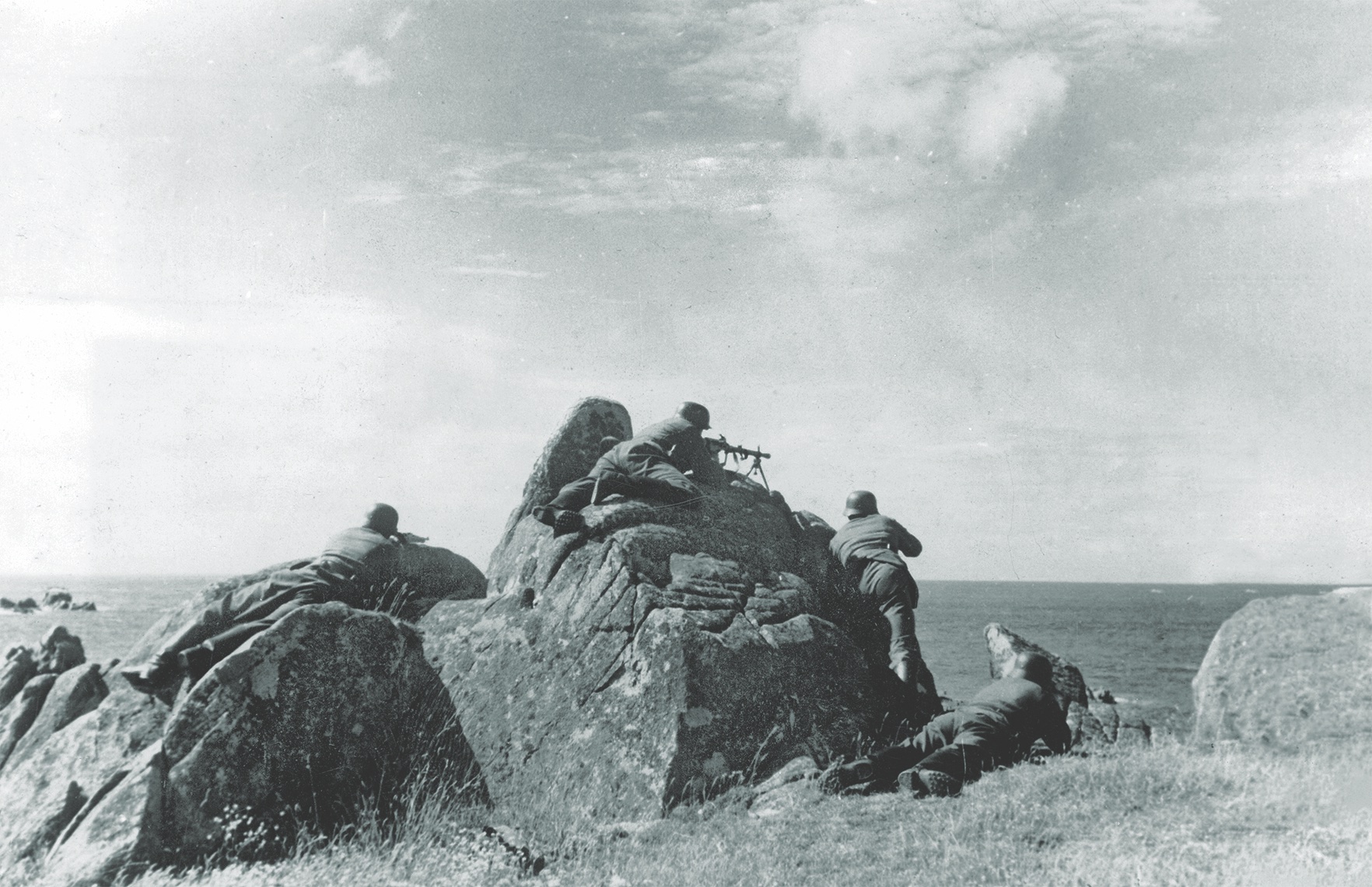
Brown notified Captain Philip H. Carlin, the commanding officer of the 3528th Ordnance Company, that several targets were approaching the Granville port. At 11:30 p.m., Brown was again advised that several targets were coming his way, so he darkened the port and sent the German POW cargo handlers back to the prison stockade.
Fifteen minutes later PC-564’s onboard radar picked up the three artillery lighters at 3,000 yards, and Sandel, who had been in command for only 12 days, ordered the 3-inch gun to illuminate the targets. A split second later, the flash of a star shell from a German ship clearly exposed the American vessel. The gunnery officer, Lieutenant (junior grade) R. F. Klinger, opened fire. Sandel directed the helmsman to bring PC-564 broadside.
PC-564 was just starting to turn when it was hit by four 88mm rounds. The first round exploded against the front of the wheelhouse, killing or seriously wounding everyone on the bridge. The blast destroyed the vessel’s magnetic compass, gyro repeater, and rudder angle indicator and knocked out the power steering. Sandel and Klinger were on the wing bridge when the first round struck. The concussion knocked Klinger down, and Sandel took some shrapnel in his left arm. PC-564’s 3-inch gun got off one round before its breech block jammed, and the crew was unable to clear it. A second 88mm round struck the mast seven feet above the gun deck, taking out both 20mm gun crews. The third hit took out the 40mm gun crew. The fourth round hit the deck, starboard side just aft of the bridge, and started a fire in the starboard officer’s cabin.
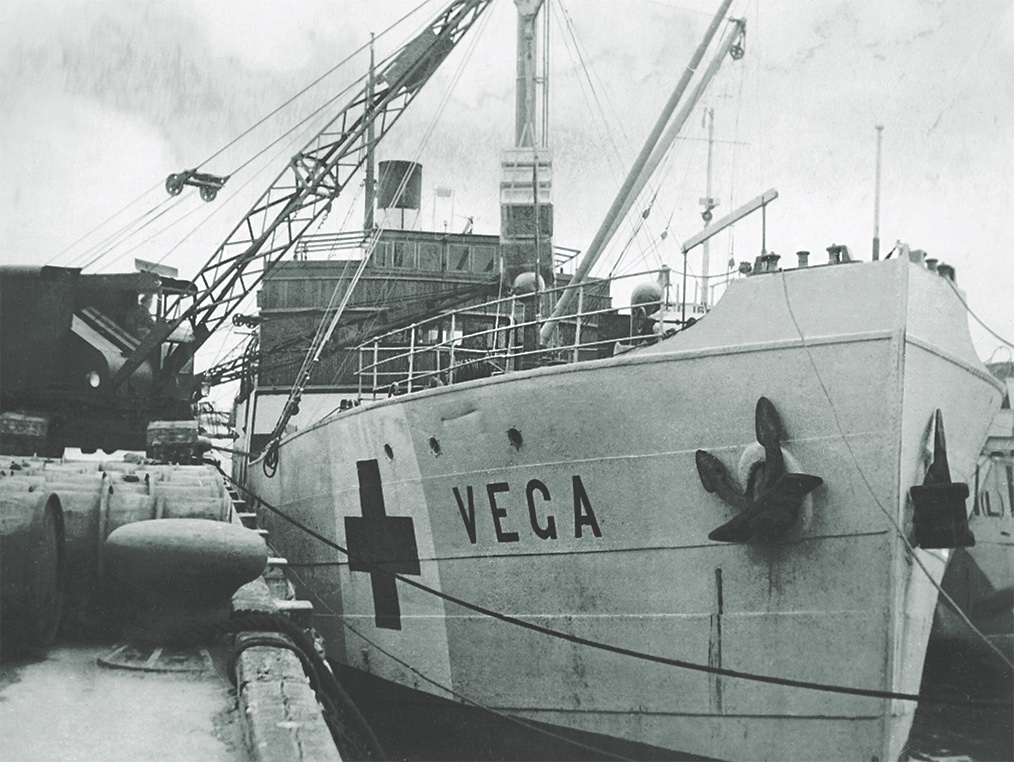
Carlin, at his 3528th Ordnance Company headquarters on the northern edge of the town, heard gunfire and saw flares in the sky south of the port. He called the naval lieutenant in charge of defense at Granville Harbour to see what was happening but got no answer. He awakened his company and issued arms and ammunition and set up a roadblock at the entrance to Granville as outlined in the harbor defense plan.
Brown and Carlin appear to have been the only officers who realized that something was wrong. The radar contacts had been widely distributed to units throughout the area, but most of the recipients thought the contacts were for informational purposes only, and no one had given a general alert or sounded sirens before the Germans attacked.
While Carlin was deploying his company, PC-564 was steaming in a circle, on fire, with all guns out of action and half the crew dead or wounded. One German ship was on its port bow, another on the starboard, and the third astern. All of them continued to illuminate PC-564 while firing into it with their 20mm antiaircraft guns. The American crewmen who were still alive and not seriously wounded were fighting the fire belowdecks, and the gun crew was still trying to clear the breech block jam.
At this point Sandel thought his ship was lost. “I decided that there was nothing we could do except abandon ship,” he said in his after-action report. “We stopped the engines and I went up the ladder with the engine room gang when Mr. Klinger came up to me and said that the Germans had ceased firing. He suggested that we make a run for it, adding that ‘we couldn’t lose anything by it anyway.’”
Sandel ordered the engines restarted and then ran forward. He shouted for everyone to remain aboard, but 10 men had already abandoned ship in the starboard life raft. They were never seen again. When he reached the bridge, a crewman pointed out the location of the Pierre-de-Herpin lighthouse. “Put the bow on the light,” Sandel told the helmsman, “and hold her there.” At 12:45 a.m. on March 9, Sandel beached PC-564 near the lighthouse. Five crewmen made the boat fast to a large rock and Sandel hustled up to the lighthouse to get help.
While the three German artillery lighters were mauling PC-564, radar station Cat Bird, at Coutainville, was reporting more targets coming out of Jersey and moving southeast. Examining the radar plots, officers at the Joint Operations Command headquarters in Cherbourg assumed that whatever the Germans were doing was probably aimed at Cherbourg and that the activity directed at Granville was merely a feint. Colonel Morris T. Warner’s 156th Infantry Regiment staff had been studying the same plots and thought what they saw indicated potential threats to both Coutainville and Granville.
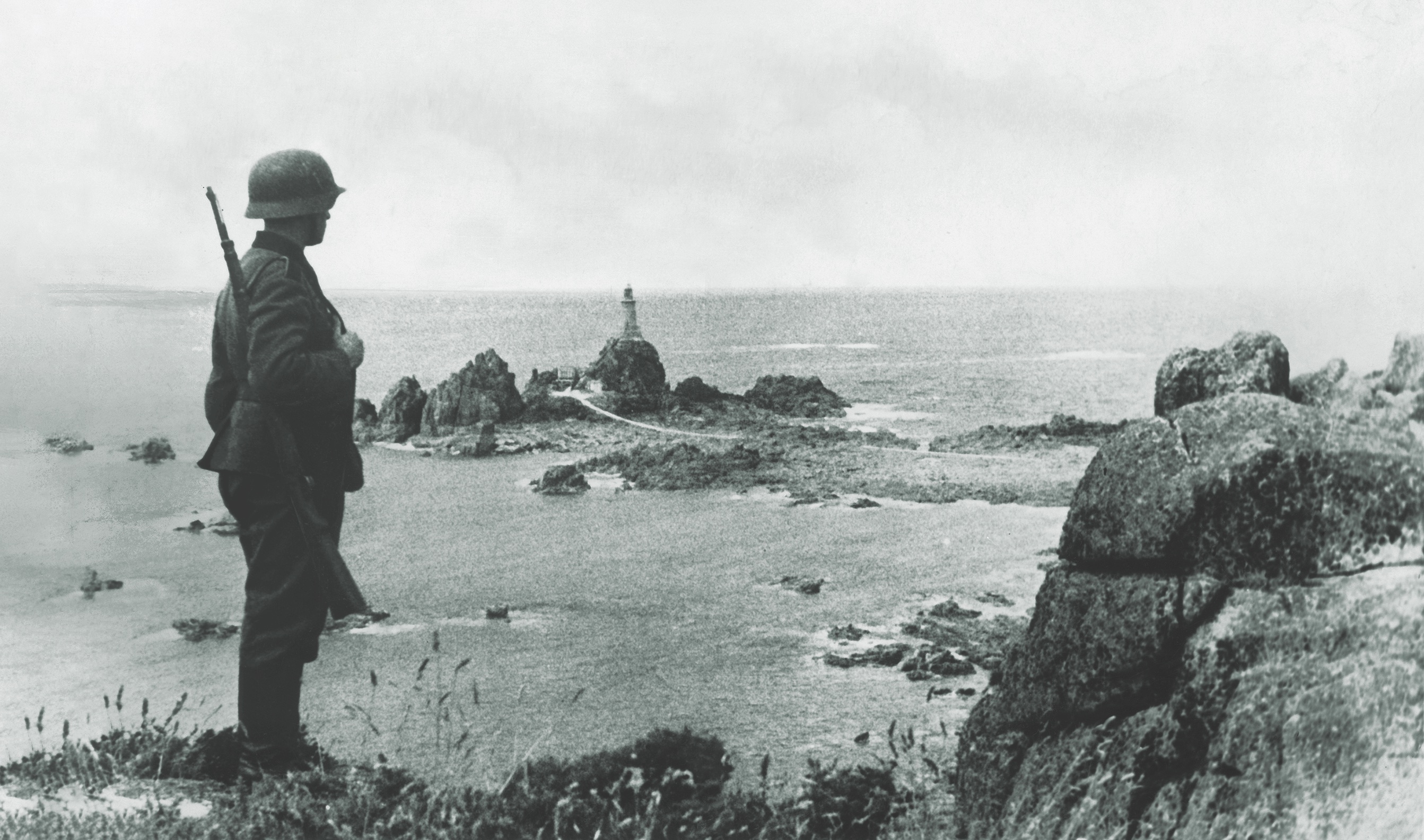
At 11:16 p.m. Warner ordered the 3rd Battalion at Coutainville to “stand to” while he waited for more information. Fifty minutes later he put the entire 3rd Battalion on alert and ordered more beach patrols. He directed the battalion’s commanding officer to alert Company M at Montmartin and Company K at Coutances to be ready for possible deployment at either Coutainville or to the south. The antitank company at Coutances was alerted and told to “be prepared for any movement that might be ordered.” Cannon Company and Company C, then en route to Coutances, were directed to continue on to Granville.
At 1:50 a.m. M412, M432, and the tug entered the outer harbor, guns blazing. M442 and M452 veered off and took up positions outside the harbor where they could support the landing with covering fire. The tug made a hard right turn and entered the inner harbor lock. As the two minesweepers continued their run across the outer harbor, headed for the east quay, M412 ran hard aground 20 yards out. M432 reached the quay, disembarking 75 German infantrymen, each armed with a Schmeisser MP40 submachine gun and carrying a satchel of explosives.
Brown and Captain T. R. Wilkinson were climbing the steps to the top of Pointe du Roc, where the Germans had built fortifications and a gun battery, when the enemy raiders entered the harbor. Brown wanted the French security unit and the 52 American riflemen garrisoned there to go to their respective defense positions. The two officers had just reached the top of the Rock, as Granville’s upper city of La Haut Ville was known, when the first artillery fire landed on the barracks. They found the Americans in their positions, but the French soldiers were still in the barracks and refused to come out. Brown tried to persuade the French lieutenant in charge to send his men into their assigned defense position, but the officer steadfastly refused, and Brown finally had to give him a direct order. Brown thought the officer may have believed the Americans were practicing.
While lead raider Mohr was trying his best to get M412 unstuck, his 75 infantrymen climbed into rubber rafts. The gunners on M412 and M432 continued firing at the town and the inner harbor. M442 and M452, positioned outside the harbor, shelled the French army barracks on the Rock and the town. The raiders quickly spread out through the harbor to destroy the cranes and other cargo-handling equipment, while five machine-gun crews set up their guns so that they covered every entrance to the harbor with enfilade fire. The plan ran like clockwork. The Germans had caught the Americans flatfooted and 15 minutes after landing were in complete control of the harbor.
Inside the harbor were five Allied coastal steamers—Eskwood, Kyle Castle, Nephrite, Parkwood—and the Norwegian vessel Heien. They were sitting ducks.
Six raiders, led by Lieutenant Scheufele, came ashore and quickly climbed the steep footpath to the top of the Rock. Their job was to attack the lighthouse, the army lookout post, and the signal station that were at the west end of Pointe du Roc. Once they reached the top of the Rock, three of them went to the lighthouse; three others, including Scheufele, charged the signal station and lookout post. Scheufele was killed in the process, becoming the only German officer to die in the raid.
Simultaneously with the landings in the harbor, 50 specially trained sailors, armed with MP40s and hand grenades, landed in rubber boats on the tidal beach on the north side of the Rock and stormed the Hôtels des Bains and Normandie. Spraying the hallways and rooms of the hotels with bullets, they killed one American officer and wounded another. After capturing nine American staff officers and a civilian—John V. Alexander, a United Nations relief officer—the Germans led their prisoners to the beach, where other raiders waited with inflatable boats. One of the captives, newly arrived Lieutenant Newell Younggren, was still wearing the pajamas his grandmother had sent him as a Christmas present.
From his vantage point atop the Rock, a worried Brown watched the raid unfold with almost no opposition. It was obvious that the members of the 514th Port Battalion, who had little combat training and carried only M-1 carbines, were no match for the heavily armed Germans. At 1:15 a.m., Brown put in a call to the 15th Infantry Regiment’s command post at Donville, asking for help.
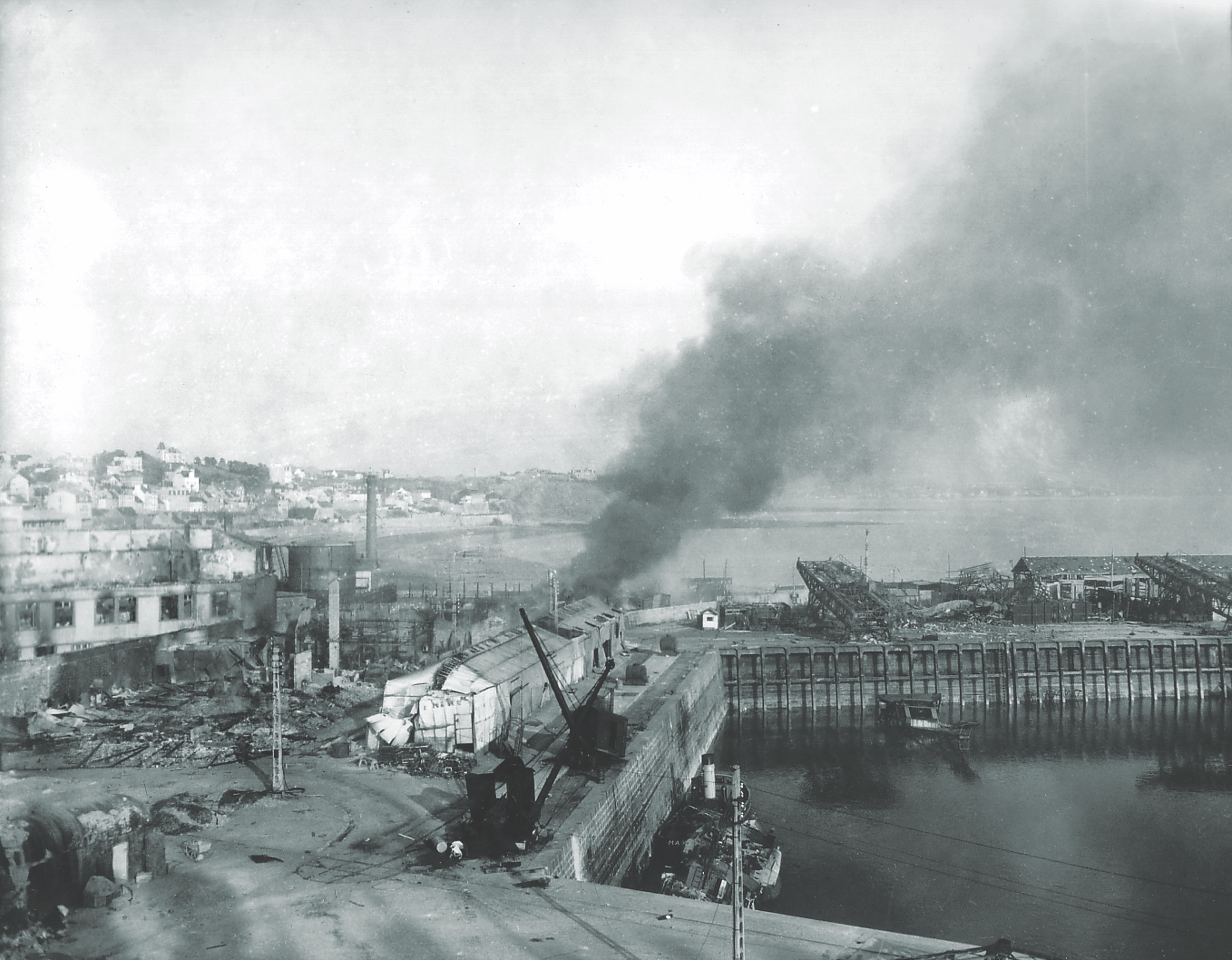
At 1:20, Lieutenants Albert Dieyerbach, Frederic Roger Lightoller, and Emil Cremery drove their jeep into the harbor and ran head-on into gunfire that forced them to abandon their vehicle and seek cover. Lightoller set out on foot to port headquarters. Later that morning his body was found outside the Hôtel des Bains.
Heroism ran in the Lightoller family. The lieutenant’s father, Charles Lightoller, had been second officer aboard the doomed luxury liner RMS Titanic, and after valiantly supervising the loading of life rafts with women and children, had leaped into the frigid water and managed to take command of one of the rafts. He was the highest-ranking ship’s officer to survive the sinking. After being awarded the Distinguished Service Cross in World War I, Lightoller, along with his son Roger, then served heroically in the spontaneous civilian evacuation of Dunkirk, repeatedly shepherding their private vessel across the English Channel and rescuing 127 of the trapped British soldiers. (A lightly fictionalized account of their actions is a main plot point in the 2017 movie Dunkirk, with Academy Award–winning actor Mark Rylance playing Lightoller.) Lightoller’s youngest son, Brian, was killed on the first day of the war as he piloted a Royal Air Force bomber in a daylight raid on Wilhelmshaven, Germany.
Just over an hour after the Germans landed in Granville, Warner moved his antitank company (less two platoons), one platoon of the cannon company, and all available reserve personnel of Company C, 3rd Battalion, from Donville to Coutances. He and his intelligence officer left the regimental command post at Donville at 1:35 to establish a temporary command post at Coutances. Before he left, Warner put Major Robert Levy in charge with orders to send the rest of Company C to Coutances. The colonel arrived at his new command post at 2:40 a.m., almost two hours after the Germans had entered Granville. He was now 14 miles from Granville and seven miles from Coutainville, having decided the German attack would be on Coutainville. When the colonel arrived in Coutances, the 3rd Battalion commander told him that one platoon from Company K and one antitank platoon had been sent from Coutances to Donville together with 10 scout cars from the 474th Infantry Regiment.
In accordance with the harbor defense plan, Carlin had established a roadblock on Highway V-171 near the entrance to Granville. Gunfire and explosions were still coming from the harbor when a captain in the 156th Infantry told Carlin that Warner would be along soon. Forty minutes passed and the colonel did not show up, so Carlin sent a messenger to the infantry at Donville. Contacting Carlin at 3:15, Brown learned that a reinforced infantry company was just outside Donville and asked Carlin to send them in.
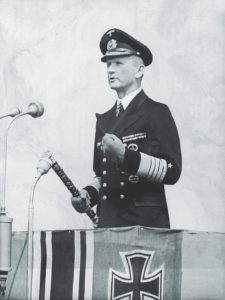
In the meantime, German prize crews had boarded four of the five colliers that were in the harbor and had met armed resistance. The shootouts were brief and one sided, a matter of pistols against submachine guns. The boarders killed a gunner and the ship’s steward on Eskwood, two officers and two gunners on Kyle Castle, the captain and two gunners on Parkwood, and three ship’s officers and three crewmen on Nephrite.
The raiders had assumed that they could take the captured ships out of the harbor, but they had miscalculated. The tide was now so low that three of the four ships were scraping the bottom. Only the smaller, 1,200-ton Eskwood was still afloat. The raiders put a scuttling charge into Parkwood’s boiler, which destroyed it and blew a hole in the ship’s starboard side. Nephrite’s boarders did the same thing, but only the boiler was damaged. The fifth collier, Heien, was not boarded and remained undamaged.
When the four prize crews were aboard Eskwood, the tug entered the inner harbor and took Eskwood in tow. The tug stopped briefly to take 62 escaped German POWs aboard Eskwood and then headed for the entrance to the harbor. Another two dozen such escapees contrived to be recaptured, preferring the comparative comfort of the Granville prison camp to the rigors of the Channel Islands. The tug cast off the towline as soon as the harbor was behind it, and Eskwood headed for Saint Helier on its own, reluctantly crewed by its captured British crewmen.
Eskwood’s departure at 3 a.m. marked the beginning of the German exodus. As the Germans were leaving, M421 was burning, and its ammunition was cooking off. The Germans continued shelling the harbor as they steamed away. Six French civilians were killed when they peered out their windows to see what was happening. A seventh civilian, a dockworker, was shot down as he ran for cover up rue General Patton.
Warren arrived at the roadblock at 3:35 with Company K and Company M. He found that the Germans had left and the commanding officer of the 3rd Battalion had already gone into Granville with two platoons. More than two hours after Brown had placed his urgent call to the command post at Donville, help had finally arrived.
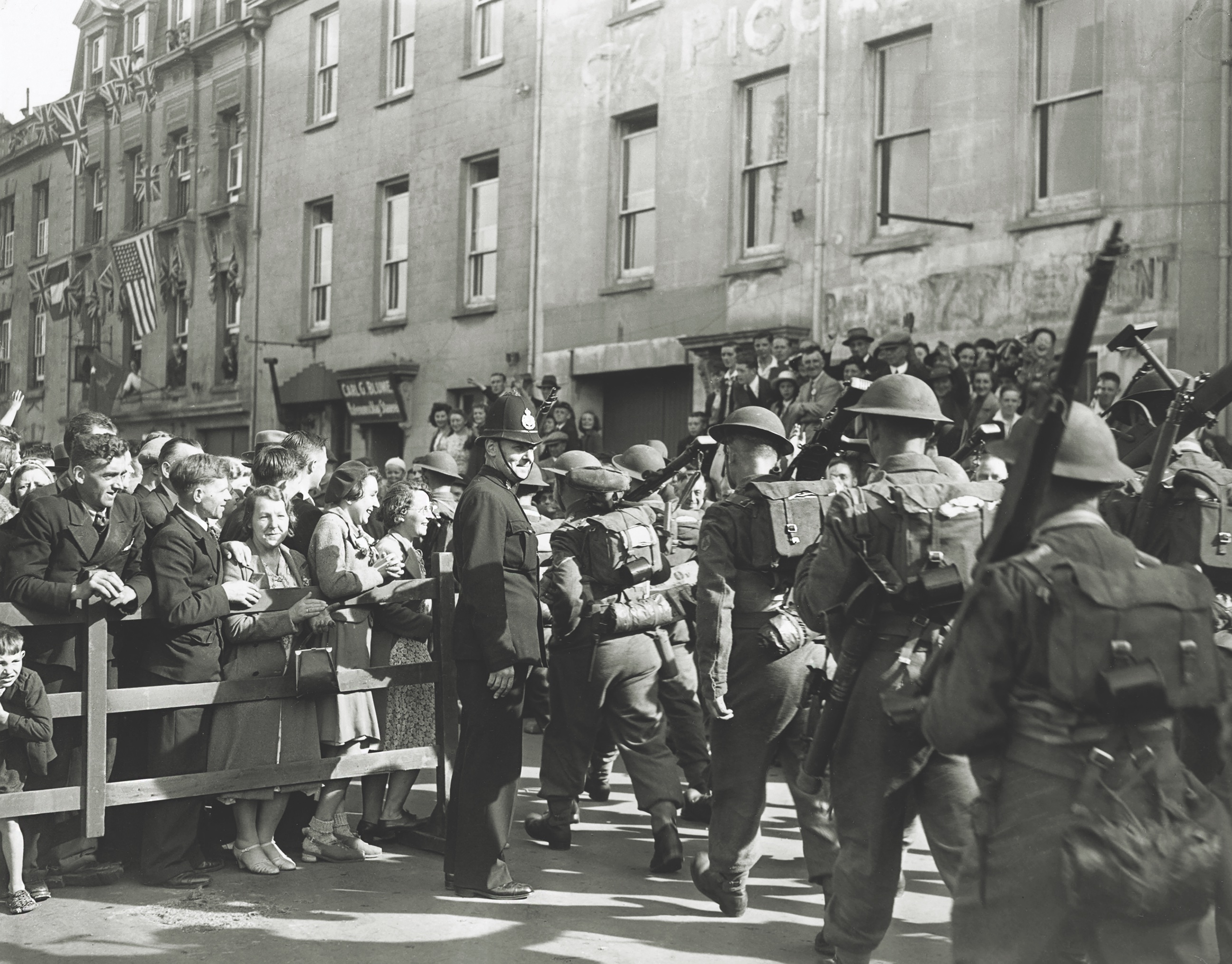
Of the German raiders, 3 were killed, 15 wounded, and 1 captured. Allied losses were 9 killed (including Lieutenant Lightoller), 40 wounded, and 67 taken prisoner. For their parts in the raid, Captain Lieutenant Mohr and Senior Lieutenant Otto Karl, the skipper of ferry AF65, were awarded the Knight’s Cross of the Iron Cross. Hüffmeier was praised specifically in a report by Grand Admiral Karl Dönitz, although most of the planning had been done under Schmettow, Hüffmeier’s predecessor.
The Americans’ relatively poor showing was hard to explain. It seemed that the 156th Infantry Regiment, which had all the heavy caliber and automatic weapons available in the area, was constantly out of position and had failed to go into the harbor when the Germans were still there. As it happened, in fact, no infantry units arrived in force until after the raiders had withdrawn. Brown, whose men bore the brunt of the attack, said bitterly, “One cannot fight 88s, .50 caliber, 20mm, and 40mm with carbines.”
Others thought that the Germans were simply better trained and armed and had caught the Allies completely by surprise. The highest praise came from Wilkinson, who said: “The weather on the morning of the raid was ideal for the purpose. There was no moon or wind and the sea was dead calm. The raid was perfectly timed and executed, and the results indicate that the personnel participating were expertly schooled and thoroughly trained to carry out their mission.”
Hüffmeier was eager to mount a follow-up raid on Granville, but Dönitz, having taken over as supreme commander of German forces after Hitler’s suicide in his Berlin bunker, ordered him not to undertake any more offensive actions. Hüffmeier was taken into custody at Jersey by British seamen on May 12, four days after Germany formally surrendered to the Allies. The rabid Nazi’s final order to his men was that they greet the victors with “Sieg Heil!” salutes. They ignored him. MHQ
Dwight R. Messimer is the author of a dozen books on military and naval history, including, most recently, An Incipient Mutiny: The Story of the U.S. Army Signal Corps Pilot Revolt (Potomac Books, 2020).
[hr]
This article appears in the Summer 2021 issue (Vol. 33, No. 4) of MHQ—The Quarterly Journal of Military History with the headline: Last Gasp at Granville

Want to have the lavishly illustrated, premium-quality print edition of MHQ delivered directly to you four times a year? Subscribe now at special savings!

